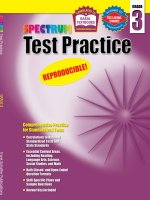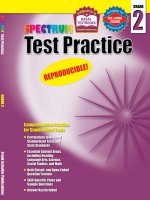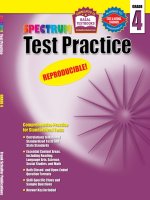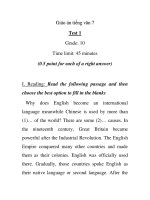Fresh reads for differentiated test practice grade 2 TM 186p
Bạn đang xem bản rút gọn của tài liệu. Xem và tải ngay bản đầy đủ của tài liệu tại đây (2.71 MB, 186 trang )
NOTES TO THE TEACHER
Introduction
Fresh Reads for Differentiated Test Practice is designed to provide
differentiated practice in reading comprehension skills and to prepare children
to take the Reading/Language Arts section of standardized tests, state tests,
or teacher-made tests. The student book includes the weekly differentiated
practice tests to strengthen comprehension skills taught in Scott Foresman
Reading Street. This Teacher’s Manual includes the following: (1) notes on
how to use the Fresh Read tests, (2) instructions on how to administer and
score a fluency test, (3) a chart on which you may record the progress of your
children, and (4) annotated copies of all of the Fresh Read tests indicating the
correct answer to all questions.
How to Use the Fresh Read Tests
The purpose of the Fresh Read tests is to give weekly differentiated practice in
target comprehension skills taught in Scott Foresman Reading Street.
This book contains three Fresh Read tests for each week to be used
independently from the main selection in Scott Foresman Reading Street. The
tests consist of a “Fresh Read” leveled passage and related comprehension
items that focus on the target and review comprehension skills of the week but
are written to address varying levels of proficiency—Strategic Intervention
(SI), On-Level (OL), and Advanced (A). A code at the bottom of each page
tells you the level of each test.
© Pearson Education 2
You can assess children’s proficiency levels using their responses to
discussion questions in class and their work on the comprehension pages in
the Practice Book or Teacher’s Resource Book. Fresh Read tests can be done
independently, or you may choose to work through them with children in small
groups, in order to give support and assess children’s progress.
Fresh Reads
v
Other ways to use the Fresh Read test pages:
• use the Strategic Intervention pages for whole-class practice with the
comprehension skills and/or test-taking skills
• use the Strategic Intervention pages after introducing the target and review
comprehension skills but prior to reading the main selection in the student
anthology of Scott Foresman Reading Street to assess children’s readiness
to read that selection
• use the On-Level pages as an assessment tool to check children’s
understanding of the comprehension skills and/or test-taking skills
• use the On-Level pages to check children’s need for further practice,
reteaching, or more challenging materials
• use the Advanced pages as a substitute for the comprehension pages in
the Practice Book or Teacher’s Resource Book for children working above
grade level
© Pearson Education 2
• use any of the pages as preparation for the unit Benchmark Test
vi
Fresh Reads
How to Identify Reading Miscues/Errors
Using the passage on page ix, the chart below shows the kinds of miscues and
errors to look for as a child reads aloud and the notations to use to mark them.
Reading Miscue
Notations
Omission
He likes to put his feet in the sand.
The child omits words or word parts.
Substitution
The child substitutes words or parts
of words for the words in the text.
He likes to hear the waves.
Insertion
The child inserts words or parts of
words that are not in the text.
He likes to see the birds in the sky.
Mispronunciation/Misreading
The child pronounces or reads a
word incorrectly.
Zhou saw the face going up and
down in the waves.
Hesitation
The child hesitates over a word and
the teacher provides the word.
Zhou likes to be near the ocean.
Self-correction
The child reads a word incorrectly
but then corrects the error.
One day, Zhou saw a little face in the
water.
water
fly
growing
H
sc
Notes
• If the child hesitates over a word, wait several seconds before telling the
child what the word is.
• If a child makes the same error more than once, count it as only one error.
© Pearson Education 2
• Self-correction is not counted as an actual error. However, writing “SC”
over the word or words will help you identify words that give the child
some difficulty.
viii
Fresh Reads
Sample Fluency Test
Here is the passage marked as shown on the previous page. This is the “OnLevel” passage from Grade 2, Unit 1, Week 1. As the child reads the passage
aloud to you, mark miscues and errors. Have the child read for exactly one
minute, and then mark the last word the child reads.
Name
Susan
9/4/2009 62
Iris and Walter
What Is It?
H
water
Zhou likes to be near the ocean. He likes to hear the waves. He likes
fly
to put his feet in the sand. He likes to see the birds in the sky.
sc
One day, Zhou saw a little face in the water. The face was dark gray.
15
31
46
The face had black eyes and a long nose like a dog. Zhou saw the face
62
going up and down in the waves.
69
growing
“Look! Look!” Zhou said to Mom.
75
Mom stopped reading her book.
80
“What is it?” Zhou asked.
85
“It is a seal,” Mom said. “Seals like to swim in the ocean. They look
for fish to eat in the water.”
107
“I like to swim in the ocean too!” Zhou said.
© Pearson Education 2
100
117
67 - 5 = 62
Total number of words read 67
number of errors
– 5
Words correct per minute
Fresh Reads
62
ix
Interpreting the Results
According to published norms for oral reading fluency, children at the end of
Grade 2 should be reading fluently at 90 words correct per minute in text that
is on grade level. This chart gives recommended progress toward that goal.
End of Unit/Grade
Reading Rate (wcpm)
Grade 2
Unit 1
50 to 60
Grade 2
Unit 2
58 to 68
Grade 2
Unit 3
66 to 76
Grade 2
Unit 4
74 to 84
Grade 2
Unit 5
82 to 92
Grade 2
Unit 6
90 to 100
End-of-Year Goal
90
© Pearson Education 2
If a child’s reading rate is lower than the suggested progress toward the
standard for his or her grade level, your notes on the child’s miscues may help
you determine why the rate is low. Does the child make errors that indicate his
or her decoding skills are poor? If so, further instruction in phonics may be
needed. Do the errors reflect a lack of comprehension or limited vocabulary?
In that case, instruction in comprehension strategies and exposure to more
vocabulary words may help. A lack of fluency may indicate a lack of exposure
to models of fluent oral reading. It may also mean that the child isn’t reading
enough material at his or her reading level. “Matching Students to Texts” in
the Additional Resources section at the back of the Scott Foresman Reading
Street Teacher’s Editions gives suggestions on increasing reading fluency.
x
Fresh Reads
Reading Fluency Progress Chart
Unit 1
Child’s Name
Date
WCPM
Unit 2
Date
WCPM
Unit 3
Date
WCPM
Unit 4
Date
WCPM
Unit 5
Date
WCPM
Unit 6
Date
WCPM
1.
2.
3.
4.
5.
6.
7.
8.
9.
10.
11.
12.
13.
14.
15.
16.
17.
18.
19.
20.
21.
22.
23.
24.
25.
© Pearson Education 2
26.
27.
28.
29.
30.
31.
32.
33.
34.
35.
Fresh Reads
xi
Iris and Walter
Name
Read the selection. Then answer the questions that follow.
A Great Day
Oscar and Emma went to the zoo. They went with their father. It
was a nice day. The animals were playing in the sun.
13
24
31
“I want to see the lions!” Emma said.
39
“Yes,” said Dad, “and we can see the bears too!”
49
They had a great day at the zoo.
57
© Pearson Education 2
“Look! Here are the monkeys!” Oscar said.
Turn the page.
Fresh Reads
Unit 1 Week 1 SI
1
Answer the questions below.
1
Which sentence tells about Oscar and Emma?
⅜ They did not like to be outside.
⅜ They were excited about their day.
⅜ They were afraid of the bears.
2
Where does this story take place?
⅜ at the zoo
⅜ at home
⅜ at school
3
What is this story mostly about?
⅜ learning about monkeys
⅜ going home after a great day
⅜ seeing animals at the zoo
What do Oscar, Emma, and Dad like to do together?
Answers may vary. Possible
response: They like going to
the zoo together.
2
Fresh Reads
Unit 1 Week 1 SI
© Pearson Education 2
4
Iris and Walter
Name
Read the selection. Then answer the questions that follow.
What Is It?
Zhou likes to be near the ocean. He likes to hear the waves. He likes
to put his feet in the sand. He likes to see the birds in the sky.
One day, Zhou saw a little face in the water. The face was dark gray.
15
31
46
The face had black eyes and a long nose like a dog. Zhou saw the face
62
going up and down in the waves.
69
“Look! Look!” Zhou said to Mom.
75
Mom stopped reading her book.
80
“What is it?” Zhou asked.
85
“It is a seal,” Mom said. “Seals like to swim in the ocean. They look
for fish to eat in the water.”
107
117
© Pearson Education 2
“I like to swim in the ocean too!” Zhou said.
100
Turn the page.
Fresh Reads
Unit 1 Week 1 OL
3
Answer the questions below.
1
Which words tell you that this story takes place at the beach?
⅜ gray, nose, dog, black
⅜ ocean, waves, sand, water
⅜ feet, sky, Mom, book
2
Which sentence does not tell about Zhou?
⅜ He likes to see birds.
⅜ He likes to read.
⅜ He likes to hear the waves.
3
How does Zhou feel when he first sees the face in the water?
⅜ mad
⅜ sick
⅜ excited
4
Which sentence tells about Mom?
⅜ She wants Zhou to know about ocean animals.
⅜ She wishes Zhou would learn to swim.
⅜ She hopes the seal would go away.
What is this story mostly about?
© Pearson Education 2
5
It is about seeing a new
animal in the ocean.
4
Fresh Reads
Unit 1 Week 1 OL
Iris and Walter
Name
Read the selection. Then answer the questions that follow.
My Great Train Adventure
It was great riding on the train to visit Aunt Rose. I climbed up the
15
steps and got on the train. I sat in a seat next to the window. The train
32
began to move slowly. “Here we go, Sam,” Dad said. I looked out the
46
window and watched the trees pass by.
53
“Tickets, tickets,” said a man in a blue jacket and hat.
64
“Sam, this is the conductor. He takes the tickets for the train ride,”
77
Dad said.
79
The man smiled and gave me a shiny pin that was shaped like the
train.
93
94
A few hours later, I looked out the window and saw a small building
108
up ahead. As the train got closer, I saw Aunt Rose standing in front of
123
the building. She was smiling and waving to us.
132
140
I cannot wait until my next train ride.
148
© Pearson Education 2
“This is where we get off,” Dad said.
Turn the page.
Fresh Reads
Unit 1 Week 1 A
5
Answer the questions below.
1
Where did the story take place?
⅜ on a boat
⅜ on a train
⅜ on an airplane
2
How did Sam feel about riding on the train?
⅜ bored
⅜ afraid
⅜ excited
3
Which detail best supports the idea that Aunt Rose was looking forward to
seeing Sam and his father?
⅜ She was smiling and waving.
⅜ She was in front of a small building.
⅜ She was the sister of Sam’s dad.
4
How can you tell the conductor was kind?
He smiled and gave Sam a pin.
Do you think Sam’s dad is a good father? Tell why or why not.
Possible response: I think
he is a good dad because he
explains things well to Sam.
6
Fresh Reads
Unit 1 Week 1 A
© Pearson Education 2
5
Exploring Space
Name
Read the selection. Then answer the questions that follow.
Honey
12
from the flowers to make honey. Then the bees take the nectar back to
26
their hive. There, they make a lot of honey. People can take honey from
40
the hive. Be careful! Honey can stick to your hands. Honey tastes good.
53
It is sweet. Thank you, bees!
59
© Pearson Education 2
Bees make honey. They fly from flower to flower. They get nectar
Turn the page.
Fresh Reads
Unit 1 Week 2 SI
7
Answer the questions below.
1
Where do bees make honey?
⅜ in the flowers
⅜ in the air
⅜ in their nests
2
What is the main idea of the selection?
⅜ Bees like to fly around.
⅜ Honey can stick to your hands.
⅜ Bees work hard to make honey.
3
What do bees need to make honey?
⅜ people
⅜ flowers
⅜ grass
Why do you think the author wrote “Thank you, bees!” at the end?
Answers may vary. Possible
response: The author likes
honey and is happy that the
bees make it.
8
Fresh Reads
Unit 1 Week 2 SI
© Pearson Education 2
4
Exploring Space
Name
Read the selection. Then answer the questions that follow.
The Ballpark
A baseball park is a great place to spend an afternoon. You can go
with your family. You can watch a ballgame.
At the game, you can see the baseball teams run on the field. You
14
22
36
can see the players hit the ball. You can cheer for the team you like.
51
You can jump up and down when your team gets a run. You can clap
66
your hands.
68
Some people like to eat hot dogs at the ballpark. Some people like
to eat ice cream. Other people do not like to eat anything at all. They
just want to watch the game.
96
102
114
© Pearson Education 2
We always have a good time at the ballpark. You can too.
81
Turn the page.
Fresh Reads
Unit 1 Week 2 OL
9
Answer the questions below.
1
What is the main reason most people go to the ball park?
⅜ to eat ice cream
⅜ to watch a ball game
⅜ to run and play
2
The author wrote this selection to
⅜ tell you about something fun to do.
⅜ surprise you.
⅜ teach you how to play a game.
3
What is the selection all about?
⅜ eating hot dogs at the ball park
⅜ the people who play baseball
⅜ things you can do at the ball park
4
Why do people cheer at the ball park?
⅜ They want to find their family.
⅜ They want to support their team.
⅜ They want to go home.
Write a new title for “The Ball Park.”
Answers may vary. Possible
response: Go, Team, Go!
10
Fresh Reads
Unit 1 Week 2 OL
© Pearson Education 2
5
Exploring Space
Name
Read the selection. Then answer the questions that follow.
To the Moon and Back
Did you ever look into the sky and think what it would be like to
15
go to the moon? In the summer of 1969, Neil Armstrong became the
28
first person to walk on the moon.
35
Armstrong flew to the moon with two other men. But it was
47
Armstrong who was the first person to walk on the moon. He and Buzz
61
Aldrin picked up rocks to take back to Earth. The rocks gave scientists
74
many facts about space. Later, other people flew to the moon too. They
87
also walked on it and brought rocks back to Earth.
97
The next time you look at the moon, think about what it must have
119
© Pearson Education 2
been like to be one of these people.
111
Turn the page.
Fresh Reads
Unit 1 Week 2 A
11
Answer the questions below.
1
What detail best supports the idea that there was much to learn from moon
rocks?
⅜ Armstrong and Aldrin picked up rocks.
⅜ The rocks gave scientists many facts about space.
⅜ Armstrong flew to the moon in 1969.
2
The author most likely wrote this selection to
⅜ make people laugh at the moon.
⅜ tell about real moon walks.
⅜ make people feel sorry for scientists.
3
What is another good title for the selection?
⅜ The Moon
⅜ Rock Scientists
⅜ Armstrong’s Walk
What is this selection mainly about?
The selection is mostly about
the first moon walk.
5
Why is Neil Armstrong important?
He was the first person to
walk on the moon.
12
Fresh Reads
Unit 1 Week 2 A
© Pearson Education 2
4
Henry and Mudge
Name
Read the selection. Then answer the questions that follow.
The Bluebird
Margaret has a treehouse in her yard. She likes to go there. She
likes to read books by herself.
13
19
27
“What are you reading?” the bird asked.
34
“I’m reading a book about horses,” Margaret answered.
42
“I like horses,” the bird said.
48
“I will read the book to you,” Margaret said.
57
And so she did.
61
© Pearson Education 2
One day a bluebird flew into the treehouse.
Turn the page.
Fresh Reads
Unit 1 Week 3 SI
13
Answer the questions below.
1
Where does the story take place?
⅜ in a treehouse
⅜ at a park
⅜ on a horse
2
Which word best tells about Margaret?
⅜ unhappy
⅜ funny
⅜ nice
3
What part of the story could not really happen?
⅜ A bird flies into a treehouse.
⅜ A bird talks.
⅜ Margaret reads a book.
Would you like to have Margaret as a good friend? Tell why or why not.
Answers may vary. Possible
response: She would be a
good friend because she is
kind to animals.
14
Fresh Reads
Unit 1 Week 3 SI
© Pearson Education 2
4
Henry and Mudge
Name
Read the selection. Then answer the questions that follow.
The Secret Room
Isaac’s Uncle Sam lived in the country. He had a big house there.
Isaac and his family lived in the city. They had a small house there.
13
27
Sometimes Isaac’s family would go to Uncle Sam’s house in the
38
summer. Isaac thought the house was too big. It made a lot of noise.
52
The house made Isaac feel scared.
58
One day Isaac heard a noise. He hid under a table by the wall.
72
When he touched the wall, it opened like a door. Behind the wall was a
87
secret room. The secret room was full of toys and books.
98
After that Isaac went to the secret room all the time. Now he feels
118
© Pearson Education 2
happy in the house, not scared.
112
Turn the page.
Fresh Reads
Unit 1 Week 3 OL
15
Answer the questions below.
1
How do you know that Isaac felt scared when he heard the noise?
⅜ He hid under a table.
⅜ He touched the wall.
⅜ He found a secret room.
2
Which sentence does not tell about the setting?
⅜ “Isaac’s Uncle Sam lived in the country.”
⅜ “He had a big house there.”
⅜ “One day Isaac heard a noise.”
3
What would make this story a fantasy?
⅜ Isaac’s Uncle Sam goes into the secret room.
⅜ Isaac finds a singing bear in the secret room.
⅜ Isaac never finds the secret room.
4
Why did Isaac feel better after he found the secret room?
⅜ He didn’t hear any noises.
⅜ He was able to stay at Uncle Sam’s house all year.
⅜ He had fun playing with the books and toys in the room.
Why do you think Isaac felt scared in Uncle Sam’s house?
Answers may vary. Possible
response: He was not familiar
with the rooms of a big house.
16
Fresh Reads
Unit 1 Week 3 OL
© Pearson Education 2
5
Henry and Mudge
Name
Read the selection. Then answer the questions that follow.
A Day at the Beach
“I’ve never been to the beach before,” said Maria. She had moved
12
from Nebraska the year before. “We don’t have beaches where I used to
25
live.”
26
“Going to the beach is like going to a carnival,” exclaimed Robert,
“because there are many things to do there.”
Robert’s mother drove Maria and Robert to the beach. When Maria
stepped onto the sand, she jumped.
46
57
63
“The sand feels strange on my bare feet,” she said.
73
Robert taught Maria how to make sand castles. When they were
84
finished, they decided to walk along the water’s edge. Robert saw a
96
shadow in the water.
“Look, Maria. That is a school of fish,” he told her. They watched
100
113
until the fish swam out of sight. Then they went into the water. The
127
waves knocked Maria down, but she didn’t mind.
135
“You were right, Robert,” Maria said on their way home. “I love the
© Pearson Education 2
38
beach.”
148
149
Turn the page.
Fresh Reads
Unit 1 Week 3 A
17
Answer the questions below.
1
How did Maria feel when she first stepped onto the sand?
⅜ tired
⅜ surprised
⅜ hot
2
Which sentence best tells about Maria and Robert?
⅜ They lived in the same neighborhood.
⅜ They did not like going to carnivals.
⅜ They were good friends.
3
Which sentence best tells about Maria?
⅜ She did not know much about the beach.
⅜ She liked taking walks every day after school.
⅜ She missed her old friends in Nebraska.
4
How do you know that this is a realistic story?
5
Would you like to have Robert for a friend? Tell why or why not.
Possible response: Yes,
because he is helpful.
18
Fresh Reads
Unit 1 Week 3 A
© Pearson Education 2
Possible response: The people
act like real children.
A Walk in the Desert
Name
Read the selection. Then answer the questions that follow.
Walk or Take the Bus?
When the weather is nice, Pedro walks to school. It takes him
12
twenty minutes. He walks with his friends. He talks to his friends. He
25
likes to walk.
28
When the weather is bad, Pedro takes the bus to school. The bus
41
55
The bus is warm and dry.
61
© Pearson Education 2
ride takes ten minutes. He sits with his friends. He talks to his friends.
Turn the page.
Fresh Reads
Unit 1 Week 4 SI
19









